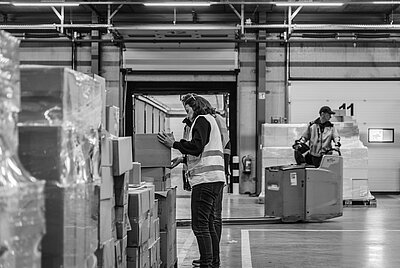But it wasn’t just the fact that they had omnichannel approaches that made them so successful. It was that they were able to pivot the way they sold quickly. In 2021, it’s not enough to simply have an omnichannel approach. You need the data behind it to make sure it’s meaningful to your customers and your employees.
It’s this data that allowed retailers to react quickly to some of the problems they were facing and, crucially, make them work for customers. Where were orders increasing or decreasing? What did customers want? How could they operate click and collect in a socially distanced world? How could they fulfil online orders with stock trapped in local stores? How could people contact them when stores were closed?
The data behind your omnichannel approach is the key to making sure it’s meaningful to your customers and your employees. And this approach is essential if retailers are going to continue to succeed at omnichannel amidst the turbulence of supply chain disruption.
Managing stock better
It’s become clear that a better way of managing stock is needed if omnichannel is to thrive. The rise of click and collect and local stores being asked to fulfil online orders has replaced the traditional retail store with mini-warehouse models. And without better stock management, this can quickly lead to chaos.
Having access to data that gives retailers, staff and customers a clearer picture of the stock available is essential in helping manage the shift in consumer behaviour. Vogue business describes this change as a ‘micro-fulfilment strategy’ and at the heart of it is inventory visibility; knowing exactly where your products are at any given time.
Many retailers are turning to RFID to help solve in-store stock problems – removing the need for manual stock takes and minimising confusion over in-store stock levels.
We saw in a previous post how Nike, one of the world’s largest retailers, was able to navigate supply chain and stock issues during the pandemic through access to data – diverting stock away from its stores to central fulfilment centres.
Whether you’re diverting stock to or away from stores, the key is that you know where that stock is at all times and how much stock you have. This multi-layered blending of data helps you to keep customer satisfaction from the omnichannel experience high.
“The ability to accurately promise against store inventory is a discipline that needs to be solved,” says Jon Chorley, Chief Sustainability Officer at Oracle.
Using data to react
Omnichannel gives retailers a wealth of data about what has happened in the past and access to data on what’s happening right now.
By capturing this rich data, it turbo-boosts the ability to predict and react to trends and events. Nobody could have foreseen the pandemic and the disruption that it caused to retail, but those who could react to it were in a much better position than those who couldn’t.
And that’s where omnichannel data comes into its own – looking at what customers value in the omnichannel journey.
In March 2020, the first month of the UK’s lockdown, click and collect orders rose by over 30% making a clear statement on what customer’s wanted from their omnichannel experience. For retailers who could make the transition easily, like Kingfisher group, this data grew their click and collect orders by over 200% and sales on mobile devices by 200%.
Being able to react to your data in real-time enables you to allocate the most appropriate staff where needed, stock the right products and put the right steps in place to keep customers happy.
What are some of the steps you can take with your omni-channel strategy to stay focussed on your data?
Invest in good technology
Whether it’s stock inventory software, digital helpdesks or online payment methods, having good technology that creates a seamless experience for your customer is essential. The data you capture from this technology will give you insight into what your customers need and want, which will inform how you tailor your omnichannel approach. Offering omnichannel is no longer enough – it must work and respond to what your customers really need.
Re-think how you use your retail space
The retail space has changed. Customers no longer want to spend long hours in stores. Safety concerns and restrictions mean that the retail space is far more functional than ever before. Using this information and changes in consumer habits will allow you to optimise your omnichannel approach. Your retail space is no longer just for people browsing – click and collect customers have different needs so reviewl your different customer types and plan their in-store journeys to give everyone what they want.
Manage your stock well
Put systems in place that ensure your stock is monitored wherever it is. Warehouse or store, it is important that you know what you have. With frequent supply chain disruption, having accurate stock insight helps to prevent shortages and ordering stock you don’t need – avoiding putting pressure on the supply chain further up. Having information on-hand to divert stock where you need it and to keep customers informed in real-time is invaluable in 2021 and beyond.
If you need advice on how to become more data driven within your omnichannel approach, then we’re here to help. You can email at online@worldpack.eu or ring us on +31(0) 88 494 20 80.


